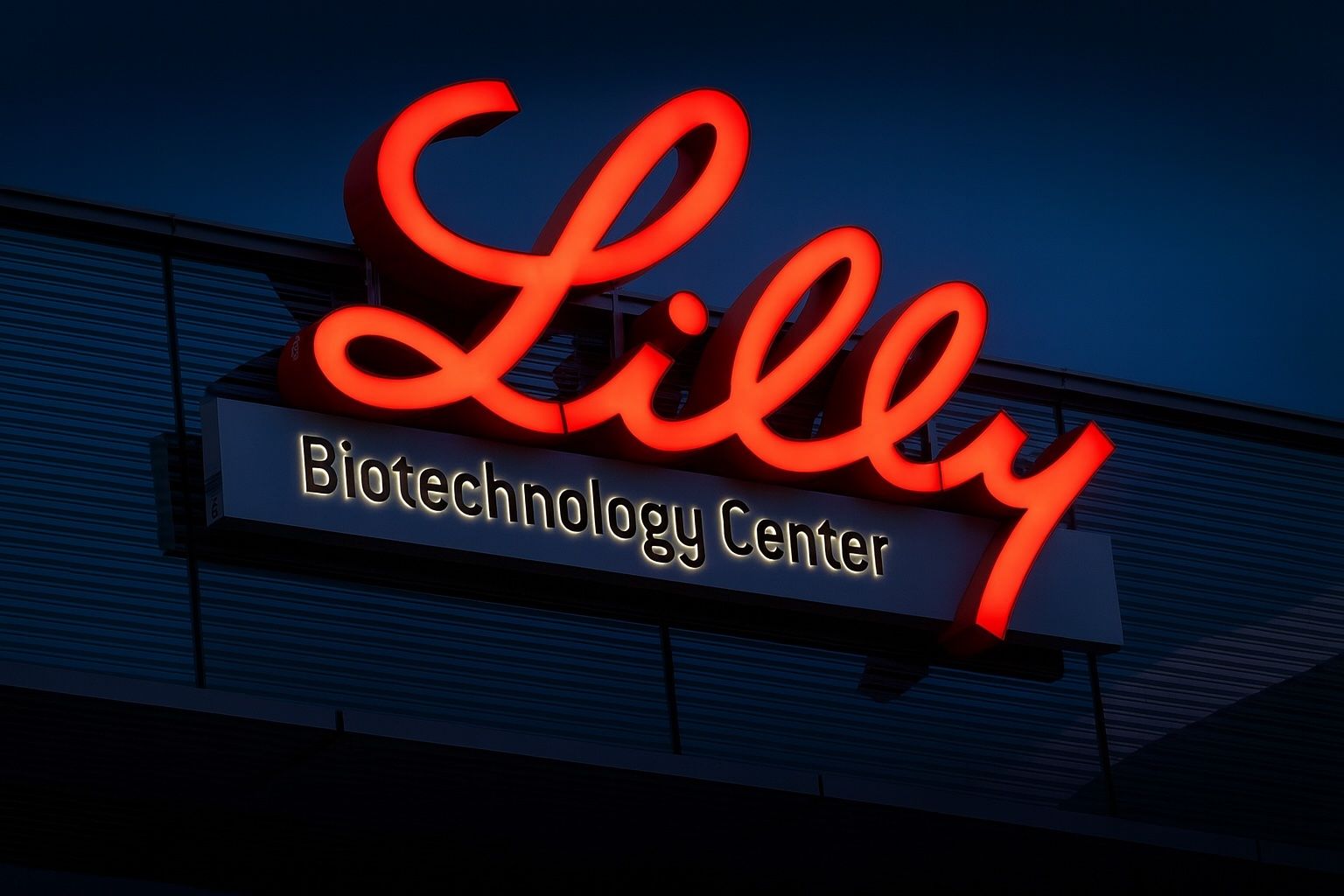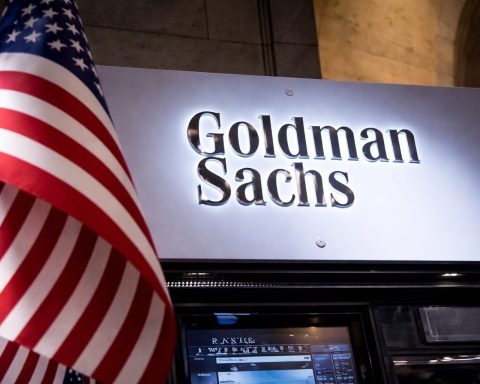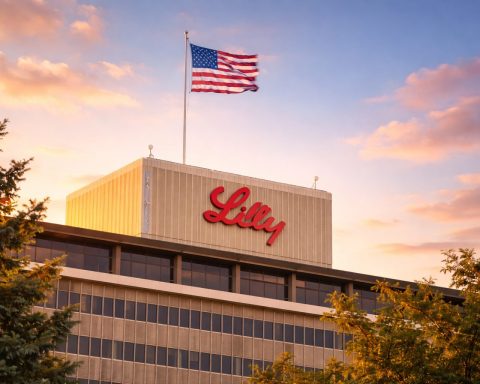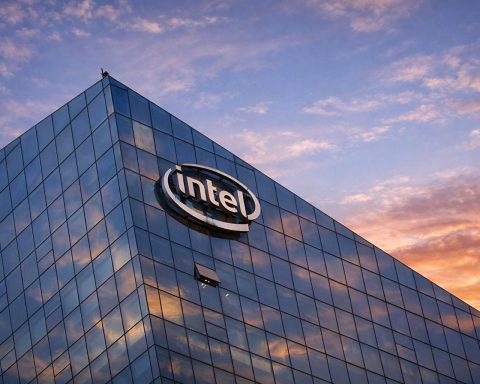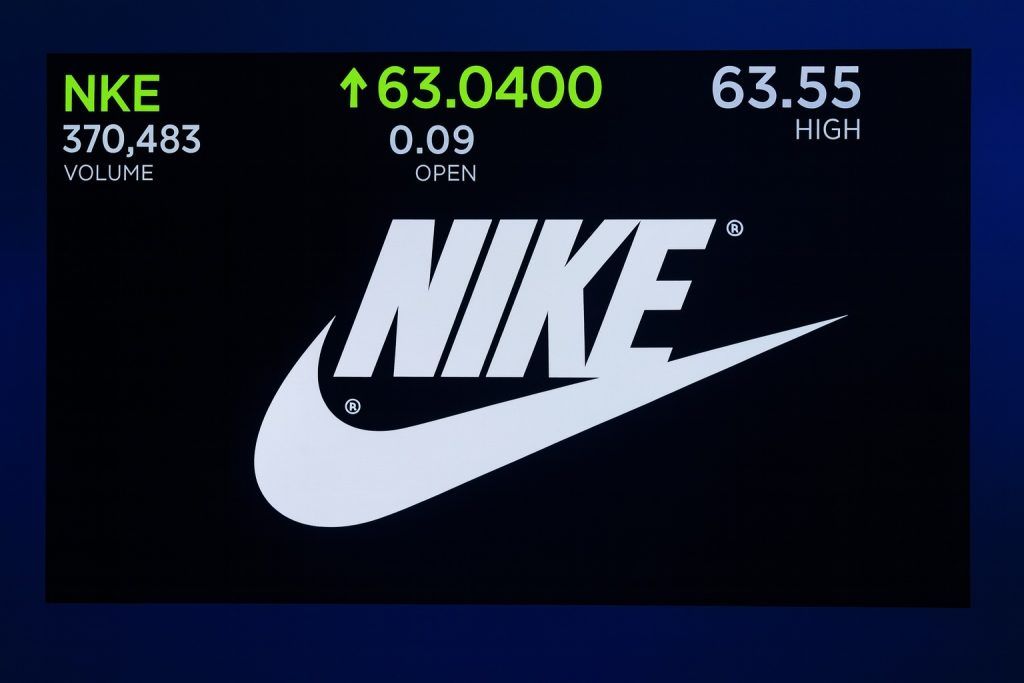- LLY jumped sharply in late Sept–Oct 1: shares surged to about $832 on Oct. 1 (+~9% intraday) [1], after closing ~$763 on Sep. 30 (versus ~$726 two days earlier [2]). Traders cite bullish options activity and growing excitement over Lilly’s weight-loss drugs and Alzheimer’s research as drivers.
- Blowout sales: Lilly’s blockbuster GLP‑1 treatments powered 45% revenue growth in Q1 ($12.73 B) and 38% growth in Q2 ($15.56 B) [3] [4]. Mounjaro (tirzepatide) and ZepBound (subcutaneous tirzepatide) were major volume drivers. The company raised full-year sales guidance to $60–$62 B [5]. Q2 EPS jumped ~92% (to $6.29) [6], and R&D milestones remained on track.
- Recent wins: In 2025 Lilly secured FDA updates and new approvals – e.g. Kisunla (donanemab) for Alzheimer’s got an updated U.S. label in July and full EU authorization on Sept 25 [7]. Positive Phase 3 results for orforglipron, its oral GLP‑1 pill, also lifted hopes (see below).
- Pipeline and deals: Lilly strengthened its pipeline via deals and acquisitions – acquiring SiteOne Therapeutics (non-opioid pain drug) for up to $1 B [8] and Verve Therapeutics (cardio gene therapy) [9]. It expanded R&D partnerships, e.g. with KeyBioscience on new obesity drugs (amylin-based DACRAs) [10] and with Insitro on AI-discovered metabolic therapies.
- Legal and regulatory: Late 2025 saw a legal challenge: Texas AG Ken Paxton sued Lilly, alleging it illegally “offered incentives” to doctors to prescribe Mounjaro and ZepBound [11]. Lilly strongly denies any wrongdoing and vows to “vigorously defend” itself [12]. Meanwhile, Lilly sued telehealth platforms for selling unapproved copies of its weight-loss drugs [13] [14].
- Analyst outlook: Wall Street remains mostly bullish. The average 12-month price target is ~$938 (≈+24% upside) [15]. One model (CoinCodex) projects an average of $768 by end-2025 and $1,031 by end-2026 [16] [17]. Long-term forecasts (2030) run even higher (many models >$2,500). Key bulls note Lilly’s growth drivers and pipeline, while skeptics point to high valuation and stiff competition (Novo’s drugs, et al.).
- Market comparison: Lilly now commands roughly 57% of U.S. GLP‑1 prescriptions (versus Novo Nordisk’s ~43%) [18]. Its revenue growth (~40%+) far outpaces big pharma peers (Novo’s H1 growth was ~18% [19], and Pfizer/Johnson&Johnson are slower). However, Lilly trades at a rich P/E (~49x) versus peers [20], implying heightened expectations. Lilly’s CEO and CFO stress that only ~4% of eligible patients currently use GLP‑1 drugs [21], suggesting plenty of runway if it can maintain share.
Stock Market Performance
In early October 2025, Eli Lilly (NYSE: LLY) stock leapt upward. After closing around $726 on Sept. 29 and ~$763 on Sept. 30 [22], it spiked to about $832 intraday on Oct. 1. Trading volumes were well above average on that run. Financial media noted a flurry of bullish option trades and news-driven optimism: a major study found that GLP-1 weight-loss drugs (like Lilly’s Mounjaro) may significantly reduce Alzheimer’s risk [23], feeding excitement about Lilly’s broad pipeline. Tip-rank and investing sites attributed the rally to strong earnings, insider buying, and renewed interest in Lilly’s obesity/Alzheimer’s franchise [24] [25]. Overall, LLY’s late-Sept gains outpaced the broader market, reflecting investor confidence in Lilly’s growth drivers.
Recent Developments & Corporate News
Lilly has been busy expanding its business and pipeline. Notable 2025 events include:
- New Approvals: On Sept. 25, 2025 the European Commission approved Kisunla (donanemab) for early Alzheimer’s treatment [26], making Lilly’s antibody available to mild-AD patients in the EU. (FDA had already approved an updated Kisunla label in July 2025 to improve dosing and safety.) Kisunla’s efficacy – “meaningful slowing of cognitive and functional decline” – was touted by Lilly executives [27]. Lilly’s eczema drug EBGLYSS (lebrikizumab) was already approved in 2024 (and is now on sale in the U.S. for moderate-to-severe atopic dermatitis), adding to its immunology portfolio.
- Pipeline Progress: In obesity/diabetes, Lilly’s oral GLP-1 candidate orforglipron posted strong Phase 3 results. In type-2 diabetes patients, orforglipron lowered A1C and body weight (average ~10.5%) [28], and in a 72-week obesity study it achieved ~12.4% weight loss [29]. Lilly plans to file for U.S. approval soon. (Novo Nordisk is also testing an oral GLP-1; competition is anticipated.) Lilly extended R&D deals on metabolic drugs: e.g. it deepened its obesity-drug partnership with KeyBioscience on dual amylin/calcitonin agonists (DACRAs) [30], and it teamed up with Insitro for AI-discovered diabetes/obesity therapies.
- Acquisitions: Lilly closed several deals to broaden its pipeline. In May 2025 it agreed to buy SiteOne Therapeutics (a small biopharma developing non-opioid pain meds) for up to $1 billion [31]. In July 2025 Lilly completed the $verve acquisition to bring in one-time heart-risk gene therapies [32]. (Earlier, Lilly also acquired Verve in 2025.) These deals underscore Lilly’s push into neuroscience, cardiometabolic and pain areas beyond obesity.
- Legal Actions: The company is also fighting to protect its market position. In April 2025, Lilly sued four telehealth firms (Fella, Willow, etc.), accusing them of selling unapproved, compounded copies of Lilly’s GLP-1 weight-loss drugs [33] [34]. The lawsuits claim these firms falsely market untested compounds to consumers. Separately, in August 2025 Texas Attorney General Ken Paxton filed a lawsuit accusing Lilly of “fraudulently” incentivizing doctors to prescribe Mounjaro/ZepBound [35]. Paxton’s complaint alleges Lilly ran illegal kickback programs (“Free Nurse Program” and support services) around its drugs. Lilly’s spokesperson denied any wrongdoing, noting previous similar claims were dismissed, and said Lilly would “vigorously defend” itself [36].
Financial Results and Guidance
Lilly’s 2025 earnings have been stellar. In Q1 2025, revenue hit $12.73 B (+45% year-over-year) [37]. Chair/CEO Dave Ricks highlighted that growth was “driven by strong sales of Mounjaro and Zepbound” [38]. Non-GAAP EPS (ex-transactions) was $3.34 (up 29%). In Q2 2025, revenues were $15.56 B (+38%) [39] and reported EPS $6.29 (+92% YoY) [40]. Volume increases (up ~50% for key products) easily offset modest price pressures. Senior management noted broad demand – roughly 7 of Lilly’s top 10 drugs saw double-digit volume rises – and major markets (U.S. and ex-U.S.) both grew strongly [41].
Guidance was boosted: full-year revenue is now forecast $60–62 B [42] (previously ~$58–60B). This outlook reflects continued strong demand for its diabetes/obesity medicines. On the call, CFO Lucas Montarce observed that only a small fraction of eligible patients are on GLP-1 therapies (around 4%) [43], implying ample runway. For the rest of 2025, analysts expect Lilly to sustain high-growth rates, benefiting from both new launches (like ZepBound) and pipeline milestones.
Expert and Analyst Commentary
Wall Street experts are mostly positive on Lilly. Analysts say the recent results “substantially de-risk” the company’s narrative. Barrons and TipRanks noted heavy bullish options flows and insider buying in Sept 2025 – signs of optimism [44]. Several analysts reiterated Buy ratings after the Q2 results. According to TipRanks data, 22 analysts rate LLY strong-buy and 18 as buy [45]. The average 12-month price target is ~$901–938 [46] [47], implying 20–25% upside.
Key voices include Lilly’s own executives and industry analysts. Lilly CFO Lucas Montarce emphasized that while GLP-1 sales are already huge, only a fraction of patients use them. “We believe significantly more patients can benefit from incretin therapy,” he told investors [48]. On the science side, Lilly’s C-suite touts upcoming innovations: Chief Scientific Officer Dr. Daniel Skovronsky highlighted orforglipron as a “more convenient alternative to injectables” that could enable early intervention in primary care [49].
Industry analysts also see big opportunities. In June 2025, RBC Capital Markets argued that if Lilly’s donanemab (Kisunla) succeeds in its late-stage AD trial, it could open a market “ten times the current Alzheimer’s segment,” potentially adding ~$4 B in U.S. sales [50]. RBC even said Lilly “could blaze a trail” for early Alzheimer’s treatments (and that Biogen’s Leqembi would then benefit) [51]. Such studies support a bullish long-term view.
Pipeline Highlights
- Obesity & Diabetes: Lilly’s weight-loss franchise is firing on all cylinders. ZepBound and Mounjaro combined for multi-billion-dollar sales in 2025, and market surveys show Lilly drugs now hold ~57% of the U.S. GLP-1 obesity market (versus Novo’s 43%) [52]. Lilly continues to advance new therapies: besides orforglipron, it’s testing next-gen dual-agonists (GIP/GLP-1) and complementary agents. The once-weekly insulin efsitora also looks promising – a phase-3 trial showed noninferior A1C control vs. daily insulin with simpler dosing [53]. Insulins, glucagon/pancreatic regulators and amylin analogs (e.g. DACRAs [54]) round out its pipeline.
- Alzheimer’s: Donanemab (Kisunla) is Lilly’s leading Alzheimer’s asset. Earlier in 2025 FDA broadened its label (allowing a titration scheme to mitigate brain side-effects), and now the EU approval in Sept 2025 [55] means Kisunla is on the market in more countries. Lilly’s head of R&D noted patients treated earlier see more benefit [56]. Meanwhile, Lilly is conducting a “pre-symptomatic” Alzheimer’s trial (TRAILBLAZER-3) in younger patients; successful results here could vastly expand the market (analysts estimate potential 25% stock upside if positive [57]).
- Oncology & Other: Lilly’s cancer pipeline is robust, with drugs like Jaypirca (BTK inhibitor for blood cancers) already on market and new ones in trials. In late 2024 it acquired Scorpion Therapeutics’ PI3K-alpha inhibitor (breast cancer drug) for $2.5 B, enhancing its oncology roster. Immunology assets (JAK inhibitors, monoclonal antibodies in lupus, atopic dermatitis, etc.) continue to progress in late-stage trials. In sum, Lilly’s broad pipeline across metabolic, neurologic, and immunologic diseases underpins the stock’s long-term narrative.
Peers and Market Context
Lilly’s performance should be viewed alongside peers. Its growth rate is among the highest in big pharma, driven by the obesity-diabetes boom. For example, Novo Nordisk – the leader in GLP-1 drugs – saw its H1 2025 revenue rise only ~18%, while Lilly nearly doubled that [58]. However, Novo still dominates overall market share globally. Lilly now splits U.S. GLP-1 prescriptions ~57/43 in its favor [59], but Novo retains strong international reach.
Compared to other pharma giants, Lilly’s valuation is premium: its P/E (around 48–49x) exceeds those of J&J, Pfizer and Merck [60]. Analysts note this rich multiple requires continuous high growth. Pfizer, for instance, is now focusing on oncology and therapies like Seagen (acquired in 2023), and it lacks a comparable blockbuster to Mounjaro. AbbVie (owning immunology drugs like Humira) has a steadier, slower-growth profile. In short, Lilly trades like a high-growth tech-like stock, reflecting investor expectations. As one strategist noted, GLP-1 penetration is still under 5%, suggesting many patients remain untapped [61] – but keeping that growth pace will mean outpacing very large rivals in a competitive market.
Outlook & Forecasts
Looking ahead, Wall Street largely remains upbeat on Lilly. As of Oct 2025, the consensus target price is in the upper $800s to low $900s [62], implying solid upside from current levels. Quant models echo this: CoinCodex’s average forecast is ~$768 by end-2025 [63], rising to ~$1,030 by end-2026 [64]. Longer-term, many price projections are very high (often $2,000+ by 2030), reflecting Lilly’s deep pipeline and reinvestment of profits.
However, market participants watch key risks: a slowdown in GLP‑1 adoption, strong competition (especially if Novo’s new oral semaglutide wins quick approval), or any hiccup in clinical trials could dampen the rally. For now, Lilly’s fundamentals are strong: Q3 2025 is expected to bring more growth, and analysts highlight upcoming launches (e.g. additional approvals for obesity, diabetes, immunology drugs) as catalysts.
In sum, Eli Lilly today looks like a high-growth pharma juggernaut. Its stock has run up recently on stellar earnings and pipeline news, and many experts still see further gains. Whether LLY can hit $1,000+ in the coming year depends on continued sales momentum and regulatory wins – a scenario analysts consider quite plausible given current trends.
Sources: Authoritative news and filings as cited above [65] [66] [67] [68] [69] [70] [71].
References
1. www.nasdaq.com, 2. www.nasdaq.com, 3. www.prnewswire.com, 4. www.prnewswire.com, 5. www.prnewswire.com, 6. www.prnewswire.com, 7. www.prnewswire.com, 8. www.prnewswire.com, 9. www.prnewswire.com, 10. trial.medpath.com, 11. www.biospace.com, 12. www.biospace.com, 13. www.hklaw.com, 14. www.hklaw.com, 15. www.benzinga.com, 16. www.benzinga.com, 17. www.benzinga.com, 18. www.pharmavoice.com, 19. www.pharmavoice.com, 20. www.benzinga.com, 21. www.pharmavoice.com, 22. www.nasdaq.com, 23. www.fiercepharma.com, 24. www.tipranks.com, 25. www.fiercepharma.com, 26. www.prnewswire.com, 27. www.prnewswire.com, 28. www.reuters.com, 29. www.pharmavoice.com, 30. trial.medpath.com, 31. www.prnewswire.com, 32. www.prnewswire.com, 33. www.hklaw.com, 34. www.hklaw.com, 35. www.biospace.com, 36. www.biospace.com, 37. www.prnewswire.com, 38. www.prnewswire.com, 39. www.prnewswire.com, 40. www.prnewswire.com, 41. www.prnewswire.com, 42. www.prnewswire.com, 43. www.pharmavoice.com, 44. www.tipranks.com, 45. www.tipranks.com, 46. www.tipranks.com, 47. www.benzinga.com, 48. www.pharmavoice.com, 49. www.pharmavoice.com, 50. www.investing.com, 51. www.investing.com, 52. www.pharmavoice.com, 53. diabetes.org, 54. trial.medpath.com, 55. www.prnewswire.com, 56. www.prnewswire.com, 57. www.investing.com, 58. www.pharmavoice.com, 59. www.pharmavoice.com, 60. www.benzinga.com, 61. www.pharmavoice.com, 62. www.benzinga.com, 63. www.benzinga.com, 64. www.benzinga.com, 65. www.prnewswire.com, 66. www.prnewswire.com, 67. www.pharmavoice.com, 68. www.prnewswire.com, 69. www.biospace.com, 70. www.benzinga.com, 71. www.benzinga.com
